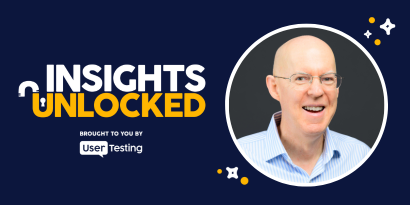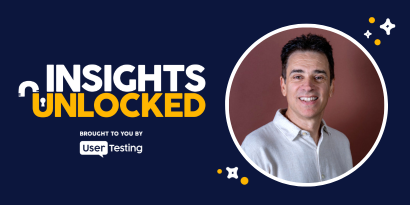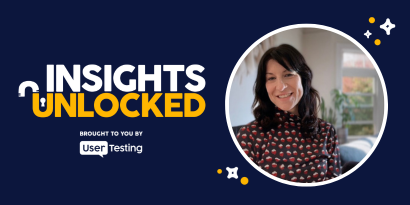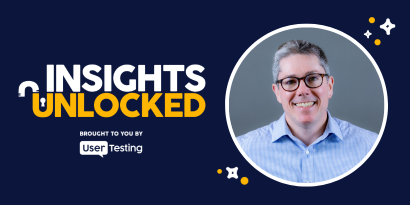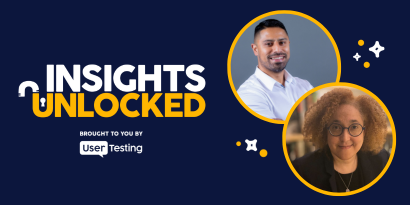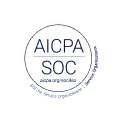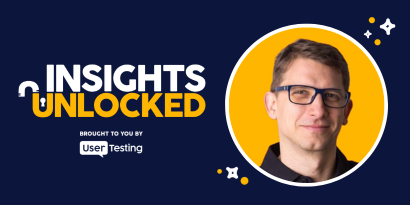
Episode 187 | September 08, 2025
Stop wasting research with Jake Burghardt
Learn how to reduce research waste and turn customer insights into action with Jake Burghardt, author of Stop Wasting Research.
How to stop wasting research and turn customer insights into action
Every organization has a treasure trove of knowledge hiding in plain sight: the past research that could reshape decisions, inspire innovation, and drive better customer experiences. Yet more often than not, that gold gets buried in dusty folders, forgotten slide decks, or siloed systems.
In this episode of Insights Unlocked, Jake Burghardt, author of Stop Wasting Research, joins host Lija Hogan to explore why research waste is such a widespread problem and what we can do about it. With experience leading insights at Amazon and Microsoft, Jake shares a practical, human-centered framework that helps teams unlock the full value of customer insights and make research more actionable.
“You don’t write a book called Stop Wasting Research unless you’ve seen it have an amazing impact, but also seen how much gets left behind,” Jake said.
Let’s dig into the themes of this conversation and what it means for product teams, researchers, marketers, and decision-makers striving to do more with the insights they already have.
Why research waste happens more than we admit
Research waste doesn’t stem from laziness or lack of rigor. Quite the opposite, most teams are working harder than ever to generate customer insights. But the challenge lies in what happens after the research is done.
Jake identifies three core reasons research often goes unused:
- Preparation: Research is packaged for a moment, not the long-term. Most studies are summarized in slide decks or PDFs designed for immediate presentation, but not for reuse.
- Motivation: Teams, both researchers and stakeholders, often view insights as optional inputs rather than essential drivers of product decisions.
- Integration: Even if insights exist and teams want to use them, they’re not embedded into the workflows, tools, or moments where decisions get made.
“The cutting room floor is full of gold,” Jake explains. “Not just in some abstract sense, but insights that directly apply to what leaders are talking about doing tomorrow.”
This gap creates a cycle of redundancy, where teams unknowingly rediscover what they already know. In fast-paced environments, that repetition wastes time, budgets, and, most importantly, opportunities to serve customers better.
Preparation: How we package insights matters
Imagine trying to build a piece of furniture using only a finished photo and no instructions. That’s often what it feels like for teams trying to reuse research that wasn’t prepared for rediscovery.
Jake suggests shifting the way we structure research outputs. Rather than only creating standalone reports, teams can build insight summaries, modular pieces that highlight a clear finding, link back to supporting evidence, and include relevant metadata (like who conducted the research, when, and for what purpose).
These summaries should act like ingredients in a well-stocked kitchen pantry: ready to be pulled out, mixed with other ingredients, and turned into something new.
“Preparation is about making research ready to be reused, not just reviewed once and archived.”
When insights are structured this way, they become much easier to integrate into ongoing planning, cross-functional collaboration, and continuous discovery.
Motivation: Building a culture that values research reuse
Another factor driving research waste is mindset. Researchers may feel pressured to move on to the next study without time to follow through on previous work. Meanwhile, stakeholders may see research as a one-time input rather than a long-term source of truth.
Jake encourages leaders to shift that mindset by:
- Celebrating reuse: Highlight when decisions were shaped by existing research. Give visibility to those who dig into past insights.
- Normalizing citations: Just like in academic work, referencing the research that informed a roadmap or design decision helps establish credibility and accountability.
- Focusing on outcomes: Encourage teams to revisit research not only for inspiration but also for measuring impact. What changed as a result?
“Sometimes being strategic is looking backward,” Jake says. “We have to build the belief that existing insights are just as valuable—if not more—than constantly doing new studies.”
This also requires creating space in researchers’ workflows for follow-through and engagement beyond the debrief meeting.
Integration: Making research visible at the point of decision
Even when teams want to use research, they often don’t know where to find it, or it isn’t available at the right moment.
Jake points out that research must be integrated into the tools and processes where decisions happen, whether that’s design platforms, product planning docs, or team standups.
He suggests several practical ways to do this:
- Link insights directly in project documents (think PRDs, Jira tickets, roadmaps)
- Use shared libraries or repositories with clear tagging and search
- Set up recurring reviews of top insights aligned with key planning cadences
This creates what Jake calls a “continuous rediscovery” loop where insights don’t just live once and die, but are regularly revisited, refreshed, and reapplied.
“It’s about connecting past learnings to present needs and making those connections effortless,” he said.
The role of AI in amplifying (or accelerating) research waste
As AI tools become more common in research operations, many are wondering: Can AI help solve the problem of research waste or will it just make it worse?
Jake’s answer is both cautious and optimistic. He sees potential in using AI to help organize, summarize, and surface insights but warns against viewing it as a magic fix.
“There’s this idea that we can throw all our research into a bucket and put generative AI on top of it. But what we need is structure, not just content,” he said. “Otherwise, we’re just creating more noise.”
Jake sees AI’s most promising uses as:
- Assisting in the creation of insight summaries
- Identifying patterns across datasets
- Mapping research citations to product documents
- Automating tedious tagging and metadata
But he also emphasizes that insight remains a human discipline. The best research doesn’t just describe what happened, it helps teams see a problem in a new way.
Connecting insights across silos
While much of the conversation centers on UX research, Jake is quick to point out that insights come from many corners of an organization—including marketing, customer success, and support.
These different disciplines often investigate similar customer problems, but their findings rarely converge. By creating shared language and centralized access to insights, organizations can begin to connect dots across silos and create a more complete picture of the customer.
He recommends:
- Structuring insights in a consistent format across teams
- Creating cross-functional insight councils or working groups
- Highlighting examples where multiple sources validated the same customer need
This not only improves decision-making but helps build a shared understanding of what really matters to customers.
Leadership takeaway: Run small experiments to reduce research waste
Jake closes the conversation with a call to action for leaders: Don’t wait to overhaul your entire research system. Start by revisiting a single study.
“Take a few existing reports that were really influential. What was left behind? What else is still useful today?” he suggests.
From there, try a small experiment:
- Revive one or two insights and present them to a product team
- Test how easy it is to find relevant research in your current repository
- Create a lightweight insight summary and track how it's used
Over time, these small efforts build a culture that values research reuse and maximizes the impact of customer insights.
Final thoughts: The real ROI of insight
Jake’s message is clear: impactful research isn’t just about uncovering new information; it’s about connecting the right insight to the right moment.
That takes preparation, motivation, and integration. But it also takes curiosity, empathy, and a willingness to think of research as more than a deliverable. It’s an ongoing conversation with your customer.
“The most strategic thing a team can do is to rediscover what it already knows,” Jake says. “And use it to build something better.”
Episode links:
- Jake Burghardt on LinkedIn
- Stop Wasting Research book; 15% off discount code SWR-POD will work through Dec 15, 2025
- Jake’s monthly Integrating Research newsletter
- Lija Hogan on LinkedIn
- Take your research to the next level: This webinar discover how to elevate your research strategy using new features and techniques in the UserTesting platform for more impactful insights
- Unlocking audience insights: driving smarter decisions across product, marketing, and UX: This guide on how to collect and apply customer feedback to inform product strategy and cross-functional decision-making
- Next level your research: from analysis to actionable insights with Steve Portigal: This episode of Insights Unlocked focused on shifting from data analysis to synthesis and making research findings truly actionable.
- How to succeed at launching a user research repository: This blog post exploring how to build and maintain a research repository so insights stay visible, reusable, and integrated into team workflows.


